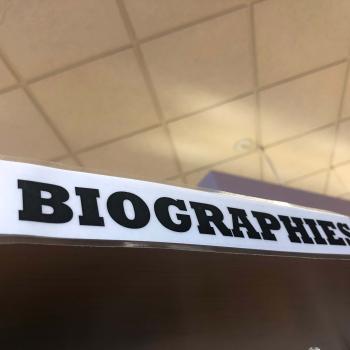Biographies: Creating Timelines of a Life

- Preview |
- Standards |
- Resources & Preparation |
- Instructional Plan |
- Related Resources |
- Comments
Overview
Studying the lives of others and reading biographies is of interest and value to young learners. In this lesson, students explore multiple sources to create a timeline about the life of a person of their choosing. The experience requires students to work together and to research and resolve potentially conflicting pieces of information about the life they research. Extension activities include developing essays from the original research.
Featured Resources
Interactive Timeline: Use this online tool to help students record events in a selected person's life.
From Theory to Practice
In order to fill the void in her students' knowledge of people with "admirable qualities," Michele Keating introduced them to the genre of biography. She states: "My objective was to expose students to the many people, past and present, who are worthy of admiration and to explore together the dedication, creativity, and achievements of these people." (66) In the end, the biographical study "broadened their view of people worth admiring." (69)
Biographies can expose our students to a whole world of people who can inspire and motivate them. In this lesson students select their own person of interest and consult multiple sources to get to know them.
This lesson was originally developed with Maggie Chase and Bess Berghoff, Indiana University 1990.
Further Reading
Common Core Standards
This resource has been aligned to the Common Core State Standards for states in which they have been adopted. If a state does not appear in the drop-down, CCSS alignments are forthcoming.
State Standards
This lesson has been aligned to standards in the following states. If a state does not appear in the drop-down, standard alignments are not currently available for that state.
NCTE/IRA National Standards for the English Language Arts
- 1. Students read a wide range of print and nonprint texts to build an understanding of texts, of themselves, and of the cultures of the United States and the world; to acquire new information; to respond to the needs and demands of society and the workplace; and for personal fulfillment. Among these texts are fiction and nonfiction, classic and contemporary works.
- 3. Students apply a wide range of strategies to comprehend, interpret, evaluate, and appreciate texts. They draw on their prior experience, their interactions with other readers and writers, their knowledge of word meaning and of other texts, their word identification strategies, and their understanding of textual features (e.g., sound-letter correspondence, sentence structure, context, graphics).
- 5. Students employ a wide range of strategies as they write and use different writing process elements appropriately to communicate with different audiences for a variety of purposes.
- 7. Students conduct research on issues and interests by generating ideas and questions, and by posing problems. They gather, evaluate, and synthesize data from a variety of sources (e.g., print and nonprint texts, artifacts, people) to communicate their discoveries in ways that suit their purpose and audience.
Materials and Technology
- Biography text sets, created using the provided Websites
- Information on your personality of choice
- Strips of paper for timeline note taking (half a sheet of legal paper, 4.25"x14"), pens or pencils) optional instead of online Interactive Timeline)
- Internet access
Printouts
Websites
Preparation
- Review the written lesson and suggested links. Gather sufficient materials to introduce the lesson—ideally 3-4 information resources for up to six personalities, to include 1) biographies written at the 2nd-5th grade level, preferably including numerous pictures and charts, 2) video tapes, and 3) Web resources. Potential personalities include famous presidents [Washington, Lincoln, Kennedy], inventors [Franklin, George Washington Carver, Madame C.J. Walker], scientists [Marie Curie, Edwin Hubble, Samuel Lee Kountz, Jr.], space explorers [Neil Armstrong, Sally Ride, John Glenn], or athletes [Jim Thorpe, Ichiro Suzuki, Lance Armstrong]. This initial selection must often be limited to personalities for whom you can locate multiple resources, but should include a range of ages, gender, cultures, occupations, and historical and modern day figures.
- Review use of the Interactive Timeline.
- Conduct a short inquiry of your own on a personality of interest as a means of introducing the lesson. Amelia Earhart is one personality for whom you are likely to find disparate information and various hypotheses regarding her disappearance. See The Last Flight Website for information and additional Web sources.
Student Objectives
Students will
- negotiate with peers to select persons of interest for their study.
- use a variety of information resources to synthesize, create, and communicate what they've learned on a timeline.
- negotiate with peers to select key events.
- research further to resolve conflicting information.
Session One: Introducing the Lesson
- Share your interest in the chosen personality and your quest for more information about that person. Leaf through a magazine article or book, sharing key events, show short clips from a video, and/or share several pieces of information on a Website.
- Highlight instances when the authors of the resources emphasize different aspects of the personality's life or when you run across conflicting dates or information. Share that resolving such conflicts is always a challenge for researchers, and generate with students an initial list of ways they might resolve conflicting source information.
- Introduce the initial set of resources, and invite groups of students to select and support with rationale two personalities worthy of the group's study among the collected resources, as well as two additional personalities (browsing the Resources section is one source for additional names). Students can make their selections on loose sheets of paper, in a bound notebook, or on the included Biography Selection & Rationale.
- Ask students to work in small groups to make the selections and generate the rationale. If there is time, ask a spokesperson to share how different group members made their selections.
- Create a whole group list of preferred choices, dividing into those for whom resources are already gathered and those that will require a search and gathering of sources.
- Ask students to make an initial choice by adding their initials after the listed name of their choice. Indicate a deadline when resources must be collected for newly generated names—over the weekend is a workable timeframe—and join the students' search for those resources. The personality from the initial set of resources can serve as a "default" choice if resources can't be located, yet note that the quality of the research is enhanced by student commitment to a personality of interest so it can be well worth the effort to help students gather resources.
Session Two: Small Group Research
- Students are seated in groups of 3-5 with sufficient resources so that each student has his or her own text on the same personality (book, magazine article, CD-ROM, Website, video).
- Ask students to browse their texts quietly, mapping the key events on their timeline paper strip. Encourage sufficient flexibility for students to invent their own ways of taking notes on the timeline. Advise that including page numbers, URLs and counter information will aid them in revisiting information if necessary.
- All begin working quietly. Circulate to encourage those who are reading page-by-page to browse key subtitles, charts or photograph annotations. The independent work period should be limited to no more than 30-40 minutes.
- As the small groups begin to finish browsing their texts, encourage them to share the gathered information among themselves. What have they found? What information is new? of interest? a surprise?
- Ask the group to agree on 6-10 key events in the life of their personality. If computer access is limited and the online timeline tool must be shared, create a schedule so each group has the opportunity to enter the key events. Note that entering data and printing out the timeline must be accomplished in one sitting.
Session Three: Debriefing the Initial Research
- Conduct a full group discussion of the groups' work: What went well, what was a challenge? Which texts were helpful? Which were less helpful? How did the group decide on key events? How will they further explore conflicting information?
- Revisit the initial list of strategies to resolve conflicting information. Add strategies as necessary. Try the strategies out on one or two key conflicts as applicable.
- Post the class-generated strategies in the school library for on-going reference.
Extensions
- Schedule additional small group work time to resolve conflicting information.
- Help teams develop short bibliographies of their resource text set, sharing the protocols for citation of the various sources.
- Create individual online timelines on figures of interest related to another course of study, i.e. world leaders, scientists, women explorers.
- Create autobiographical timelines.
- Recreate paper timelines, using colored pencils or fine tip markers to add illustrations.
- Use timelines as "notes" to write a fuller biography essay. One potential online tool that helps students manage their ideas and writing can be found at The Biography Maker Website.
- Begin another round of biography research, challenging students to research alone or in pairs, using the strategies developed in these introductory lessons.
- Categorize the attributes of the famous people you have studied. See the Images of Greatness Website as one example by a 4th/5th grade class.
Student Assessment / Reflections
- Group conversation
- Timelines

Add new comment